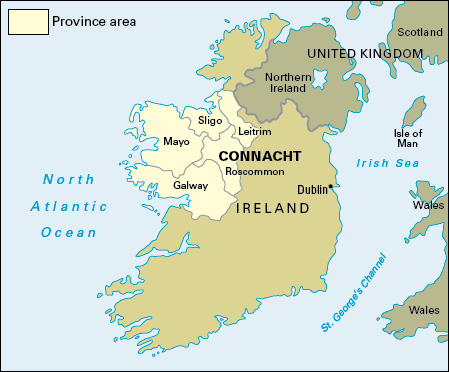Connacht is one of the four provinces of Ireland. It is in the western part of the Republic of Ireland and is the most remote of the provinces. It developed more slowly than other parts of the country and has a long history of immigration. Connacht is also spelled Connaught. In Irish, the province is called Cúige Chonnacht.

Connacht consists of counties Galway, Leitrim, Mayo, Roscommon, and Sligo. The province covers an area of 6,610 square miles (17,121 square kilometers). The largest city is Galway.
Irish customs and traditions have generally survived longer in Connacht than elsewhere in the country. Many people use the Irish language in everyday speech in the Gaeltacht areas. These areas cover large parts of County Galway and County Mayo. Elsewhere in Connacht, English is the everyday language. See Gaelic languages; Irish language.
Most farms in Connacht are small. Mountains and peat bogs unsuited to agriculture occupy one-third of the province. Peat bogs support many animal and plant species. They also play an important role in storing carbon that can contribute to climate change if released into the atmosphere. Much of the farmland is not fertile, except in the east. It is used mainly for growing grass for livestock. Beef cattle production is the principal type of farming in all of Connacht’s counties, but there is some dairy farming. There are many sheep in the uplands and on the lowlands of the southeast. The main crops are barley, oats, and potatoes.
A wide range of manufactured goods is produced in Connacht, but the most common type of modern industry is light engineering. Other industries include the production of chemicals and wood products, food processing, printing, and textile and clothing manufacture. Galway is the main industrial center.
Tourism is an important source of income, especially in coastal areas. Salthill, a seaside suburb of Galway, is the main resort.
Fishing is important in several coastal districts, especially in County Galway. Many people combine fishing with farming as a means of earning a living. Marble is quarried in County Galway.
People have settled in Connacht since Stone Age times. Ancient monuments are especially common in County Sligo and in the northern part of County Mayo. Connacht was one of the ancient kingdoms of Ireland. One of its most famous legendary rulers was Queen Maeve (see Maeve, Queen). Celtic monks founded monasteries from the 400’s, and monks from Europe also built monasteries from the 1100’s. The Connacht rulers Turlough O’Connor and his son Rory were recognized as kings of Ireland during the 1100’s.
After the Anglo-Norman invasion of the 1200’s, much of Connacht was ruled by Richard de Burgh. The earliest towns were founded at this time. Connacht long remained one of the most Gaelic areas in Ireland (see Gaeltacht). In the 1600’s, Connacht became a refuge for homeless people from other parts of the country. It suffered more than other parts of Ireland during the Great Famine of 1845-1850 (see Great Irish Famine). In 1879, some children in the tiny village of Knock claimed to have seen visions of the Virgin Mary. Since then, Knock has become a place of pilgrimage for Roman Catholics from all over the world.
